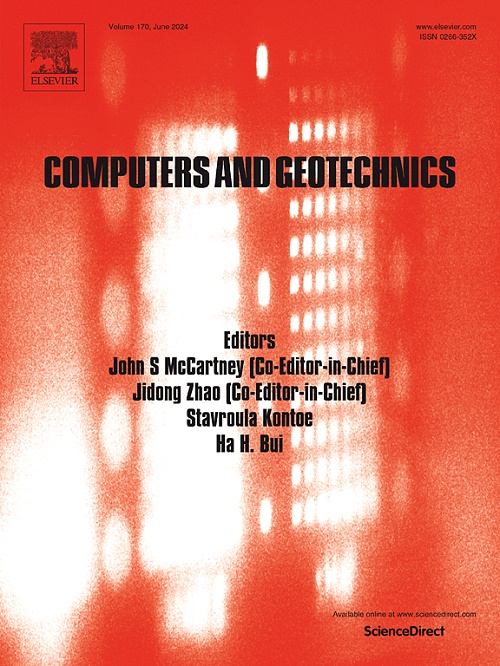Permeation diffusion mechanism of pulse grouting with Bingham fluid considering tortuosity and spatiotemporal variations in viscosity
IF 5.3
1区 工程技术
Q1 COMPUTER SCIENCE, INTERDISCIPLINARY APPLICATIONS
引用次数: 0
Abstract
Understanding the antiseepage and reinforcement mechanisms for pulse grouting remains inadequate at present compared with its engineering applications. To improve the theoretical framework of pulse grouting, a permeation diffusion model based on a Bingham fluid is developed, which incorporates the tortuosity of the slurry diffusion path and spatiotemporal variations in viscosity. The validity of the model is verified through a comparison of the theoretical predictions with the experimental results. The impacts of spatiotemporal viscosity variations and tortuosity on the slurry diffusion mechanism are evaluated via theoretical analysis. The permeation diffusion characteristics of pulse grouting and conventional methods are comparatively simulated and analysed via the COMSOL Multiphysics platform for secondary development. The results show that (i) the maximum relative discrepancy between the theoretical predictions and experimental measurements is less than 30 %, which can be further reduced to under 10 % with increasing grouting pressure, indicating that the theoretical model can offer valuable guidance for the design and implementation of pulse grouting projects. (ii) The spatiotemporal variations in slurry viscosity and the tortuosity of the diffusion path significantly affect permeation diffusion, which intensifies as the grouting pressure and duration increase. The theoretical diffusion distances without considering these two factors are 1.36 ∼ 1.74 times and 1.1 ∼ 1.32 times greater than the experimental results, respectively. (iii) The diffusion morphology of pulse grouting demonstrates a reduced range and a more uniform front under identical conditions, indicating that pulse grouting has significant advantages in the ability to control slurry diffusion compared with conventional methods.
考虑弯曲度和黏度时空变化的Bingham流体脉冲注浆渗透扩散机理
与脉冲注浆的工程应用相比,目前对其防渗加固机理的认识还不够充分。为了完善脉冲注浆的理论框架,建立了基于Bingham流体的渗透扩散模型,该模型考虑了浆体扩散路径的弯曲度和黏度的时空变化。通过理论预测与实验结果的对比,验证了模型的有效性。通过理论分析,探讨了时空黏度变化和弯曲度对浆料扩散机制的影响。利用COMSOL多物理场二次开发平台,对比模拟分析了脉冲注浆与常规注浆的渗透扩散特性。结果表明:(1)理论预测与实验测量的最大相对差值小于30%,随着注浆压力的增大可进一步减小到10%以下,表明该理论模型对脉冲注浆工程的设计与实施具有一定的指导意义。(ii)浆液黏度和扩散路径弯曲度的时空变化显著影响渗透扩散,且随注浆压力和持续时间的增加而加剧。不考虑这两个因素的理论扩散距离分别是实验结果的1.36 ~ 1.74倍和1.1 ~ 1.32倍。(iii)在相同条件下,脉冲注浆的扩散形态范围缩小,锋面更加均匀,表明脉冲注浆在控制浆体扩散能力方面比常规方法具有显著优势。
本文章由计算机程序翻译,如有差异,请以英文原文为准。
求助全文
约1分钟内获得全文
求助全文
来源期刊

Computers and Geotechnics
地学-地球科学综合
CiteScore
9.10
自引率
15.10%
发文量
438
审稿时长
45 days
期刊介绍:
The use of computers is firmly established in geotechnical engineering and continues to grow rapidly in both engineering practice and academe. The development of advanced numerical techniques and constitutive modeling, in conjunction with rapid developments in computer hardware, enables problems to be tackled that were unthinkable even a few years ago. Computers and Geotechnics provides an up-to-date reference for engineers and researchers engaged in computer aided analysis and research in geotechnical engineering. The journal is intended for an expeditious dissemination of advanced computer applications across a broad range of geotechnical topics. Contributions on advances in numerical algorithms, computer implementation of new constitutive models and probabilistic methods are especially encouraged.
 求助内容:
求助内容: 应助结果提醒方式:
应助结果提醒方式:


